
Trello vs Jira: Similarities
We’ll begin this comparison by looking at the aspects that Trello and Jira share.
Task Management Tools
When it comes to task management tools, we’ll start by looking at the similar native tools that Jira and Trello offer. The first and main one is a kanban board (which can also be used as a scrum board).
Coming from the Atlassian family, each board is well made, and it’s easy to assign your project’s tasks to other users. Moving tasks through each stage of your project and tracking project progress is also straightforward.
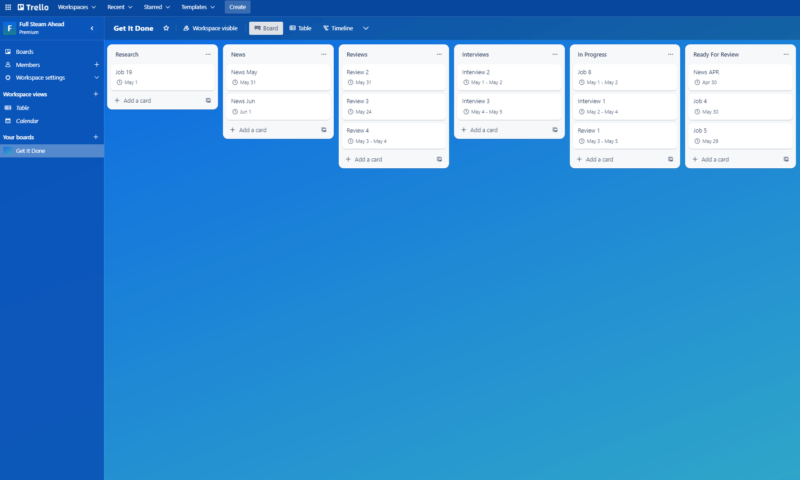
Simply put: Trello boasts the best kanban board on the market.
Next is the timeline view. Timeline views borrow heavily from Gantt charts, so if you’re familiar with them, then using this view won’t be a problem.
The slight difference is that Jira’s comes out of the box with Agile terminology such as “epics,” whereas Trello will mirror the terminology you used for your kanban view. You can use a table and a calendar view on each platform as well.
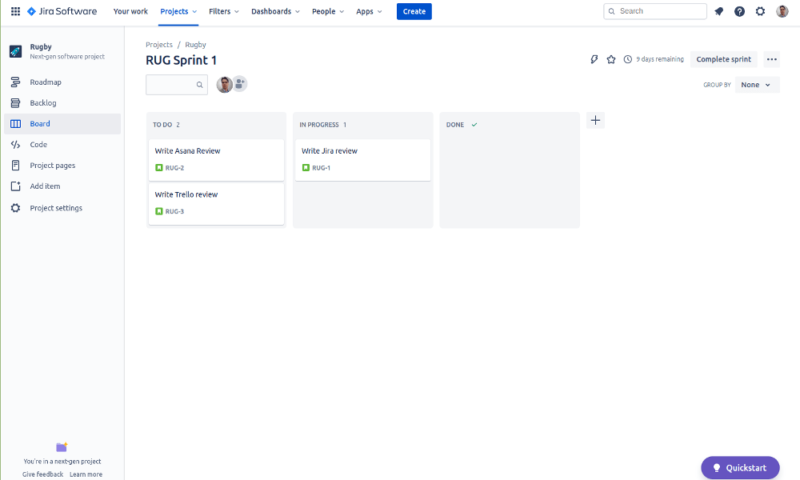
Jira’s board is simplistic and won’t overwhelm you.
User-Friendliness
A huge selling point of both services is their ease of use. This is especially important if you use the Jira Work Management solution, as it helps novice users get started with Agile project management, a notoriously complex approach.
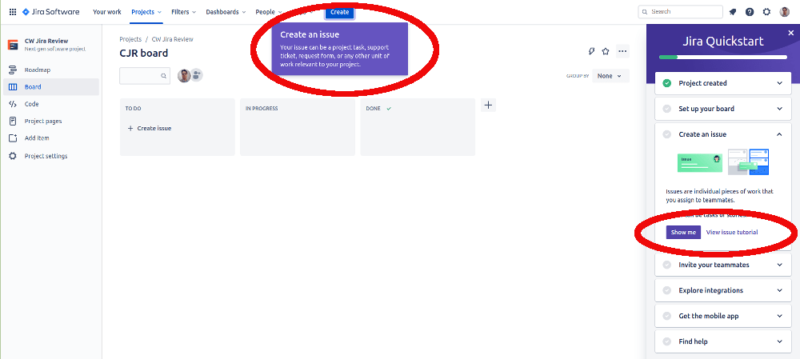
Jira’s quickstart menu helps you get accustomed to the app.
At the foundation of each platform is great design. They both provide straightforward navigation that makes it easy to jump from one feature to the next. The fonts are easy on the eye, and each section of the software is streamlined, which helps to avoid overwhelming users with project data.
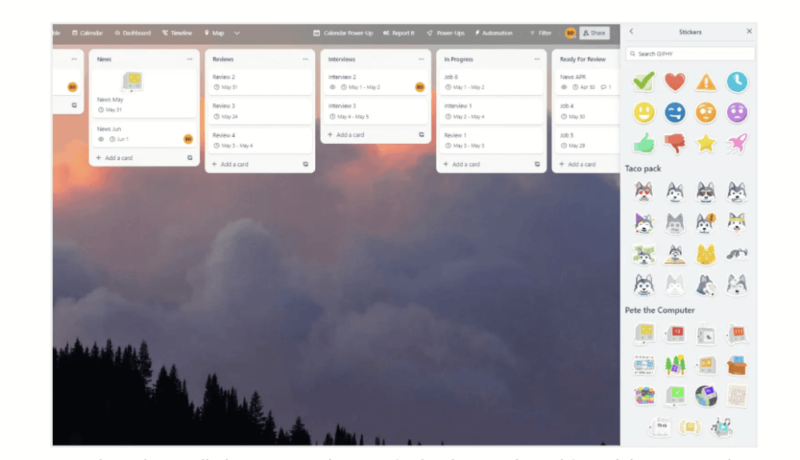
What you see is what you get with Trello, and it takes little
time to figure out how to use the platform.
Integrations
Trello and (especially) Jira understand that their out-of-the-box product is a little thin on features. Thankfully, both of them have native integrations plus a boatload of third-party integrations to choose from.
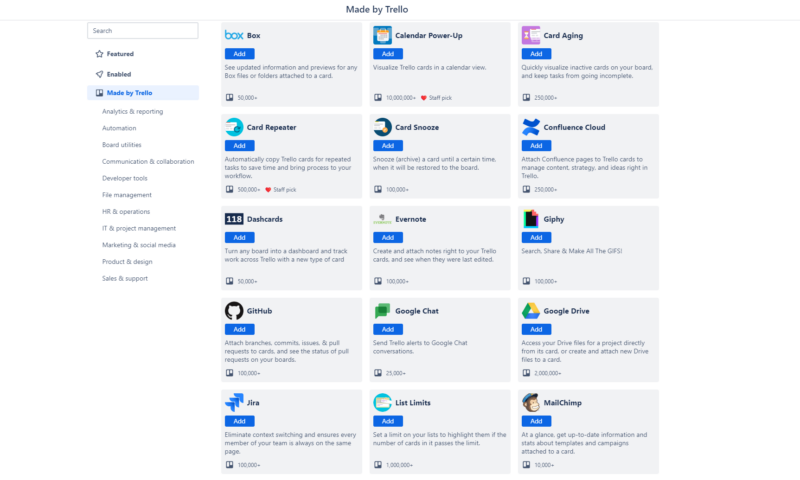
Users have 201 different integrations to choose from when using Trello.
Integrations on each platform can expand your task management tools, help run automations and sync the best cloud storage services. Jira also has integrations for design teams, including the ability to link with Adobe, Figma and more. Although their integration options aren’t identical, both Jira and Trello offer enough for them to be on par in this department.
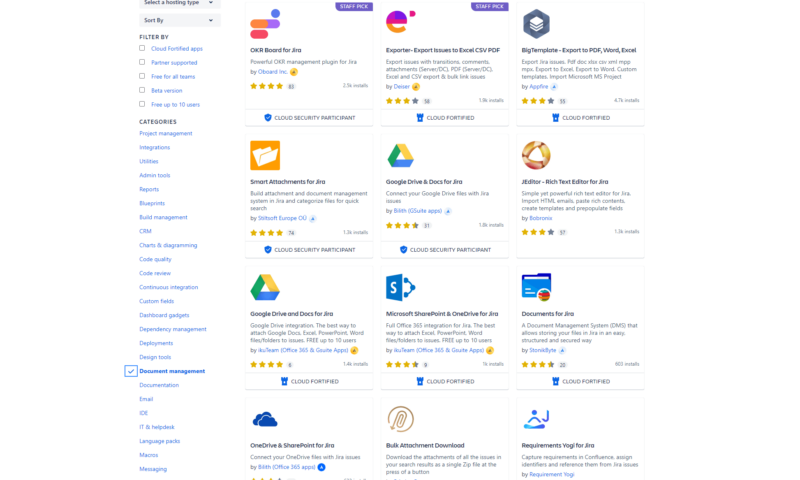
Jira’s integrations lean heavily towards design, but other options are available.
Free Version
Trello and Jira are among some of the best free project management software available. Jira lets you work on unlimited projects. Trello is limited to 10, but you can create an unlimited number of tasks. Jira imposes a user limit of 10, which is still decent, making it an ideal project management solution for small teams. Trello supports unlimited users, which is a huge plus point.
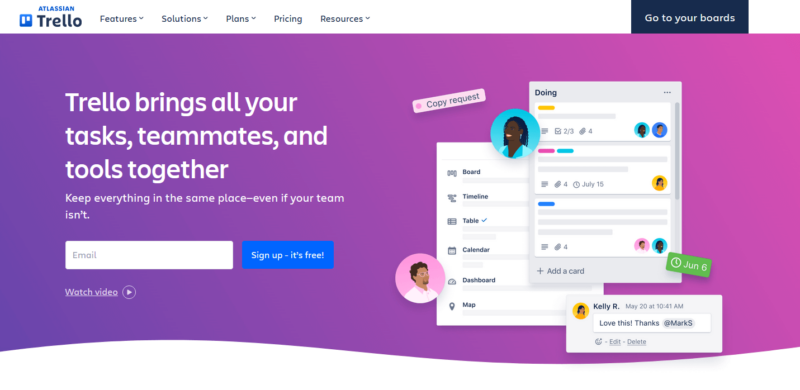
Trello’s free plan is suitable for personal projects and those working in multiple teams.
We should note that plenty of functionality is missing on both of their free versions. For example, Trello doesn’t let you use its timeline view as well as some other views, while Jira limits its reporting features and some features pertaining to user permissions.
Security
Standard security measures are in place on both platforms. Atlassian uses Amazon Web Services (AWS) for all its platforms, and this practice is common throughout the whole online project management community.
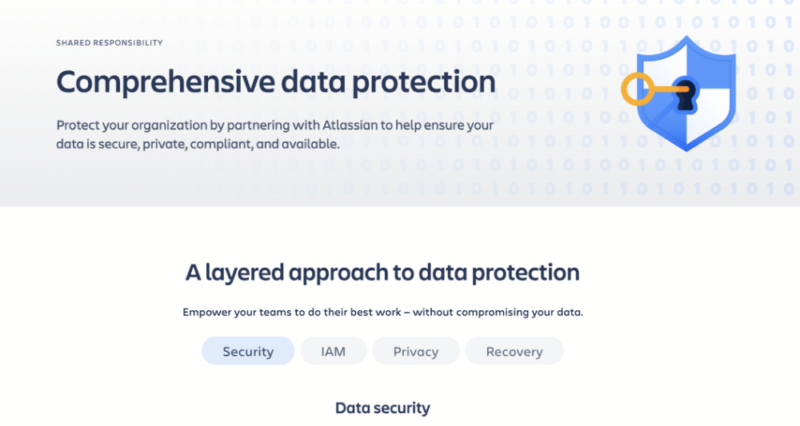
Atlassian oversees security for both Trello and Jira.
This means the company hosts all user data on AWS. With that, your data is encrypted through 128-bit AES encryption when it is in transit and AES-256 encryption when it is at rest. Two-factor authentication is also available to make it harder for hackers to access your accounts.
Each service offers more premium security features when you pay for it. For example, Jira lets you choose where in the world your data is stored, and Trello charges extra if you wish to use SAML single sign-on. Each service is SOC 2 Type 2 certified, so you can have full confidence that your data is secure.
Privacy
Privacy buffs won’t be pleased to read that Trello and Jira have let themselves down in this department. Both track what you do inside the platform. They also share your personal data with third-party companies, which can then be used to send targeted ads and email campaigns in your direction. It’s not the end of the world, but it’s not great either.
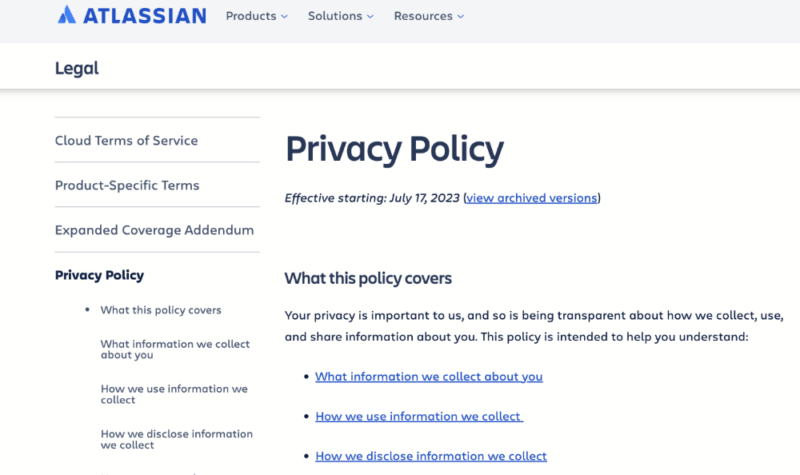
Hopefully, we’ll see improvements to the privacy policy in the future.
Automations
You can create automated workflows on both platforms, and both work similarly.
With Jira, you can automate notifications whenever an issue is raised inside the platform. Thanks to Jira’s automation builder and the Trello Butler, you can set up automations for changes in tasks, assignees and due dates. You can play with them both a little further and experiment with their capabilities to create a workflow that suits you.
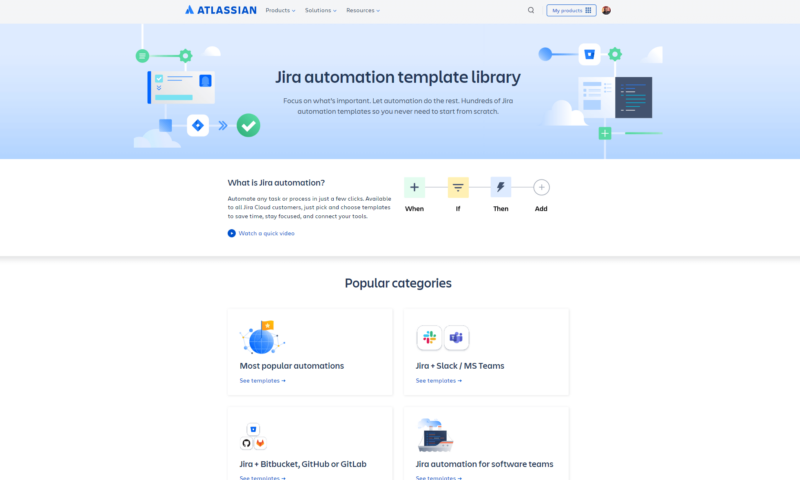
Workflow automations can really speed things up and remove the need to do menial tasks.
Customer Support
On the whole, Atlassian offers good support across all its products, and Jira and Trello are no different. Each service has a community forum where you can tap into the knowledge of other users if you need help with an issue. There are also plenty of tutorials available to help you get better accustomed to each platform.
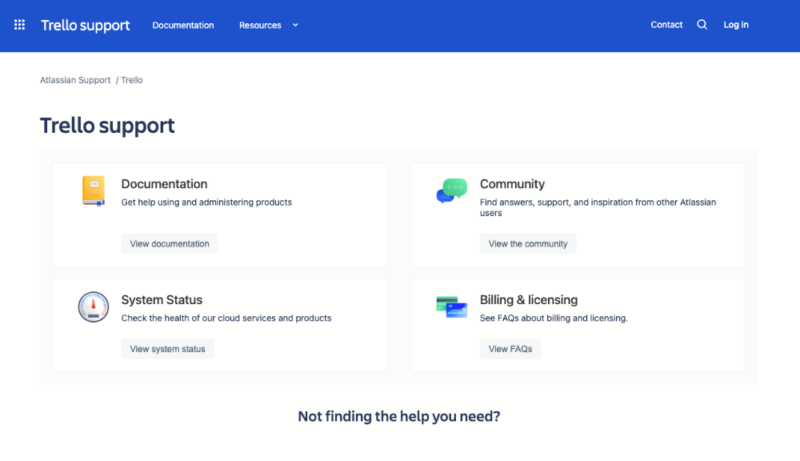
Trello’s premium customer support is decent enough; we
just wish it would expand the service to all plans.
Paid plans open up the option of direct support from a member of the support team. Jira offers 24/7 support on its Premium and Enterprise plans, and Trello offers 24/7 support on its respective plans. Both platforms fared well when testing the response quality of the support teams.
Collaboration
Unlike Notion, ClickUp and other platforms, Jira and Trello aren’t the best for company-wide collaboration. They’re not total dead ends either. You can package Jira and Trello with Confluence, another product from the Atlassian family.
This allows you to brainstorm ideas, create documents for events like sprint retrospective meetings and generate dedicated spaces for multiple departments in your company.
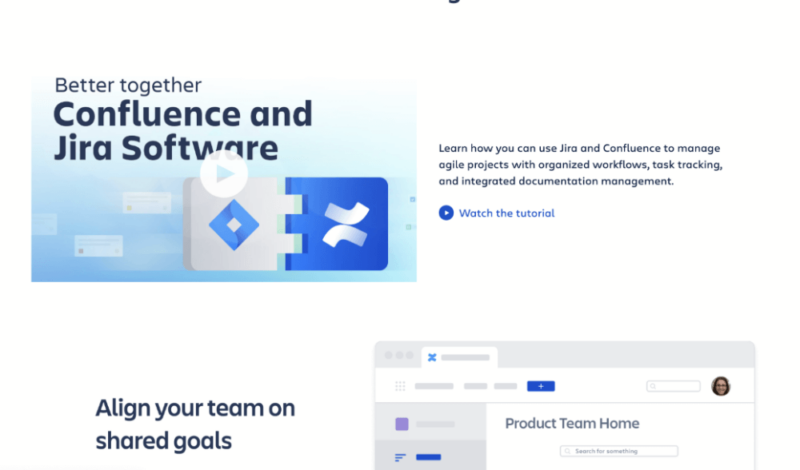
You can expand productivity by integrating with Confluence,
a pretty decent document creator.
Without Confluence, both the Trello and Jira software lack strong collaboration tools. We recommend reading our Notion review if that’s what you’re looking for. You can also read this Notion vs ClickUp comparison to help you decide between the two.
Jira vs Trello: Differences
In this section, we’ll take a look at the main differences between each platform.
Complex vs Simple Projects
The biggest difference project managers should look out for is what you can do with each platform. Compared to most other services, Jira and Trello are limited. A simple space to create to-do lists isn’t present on either platform.
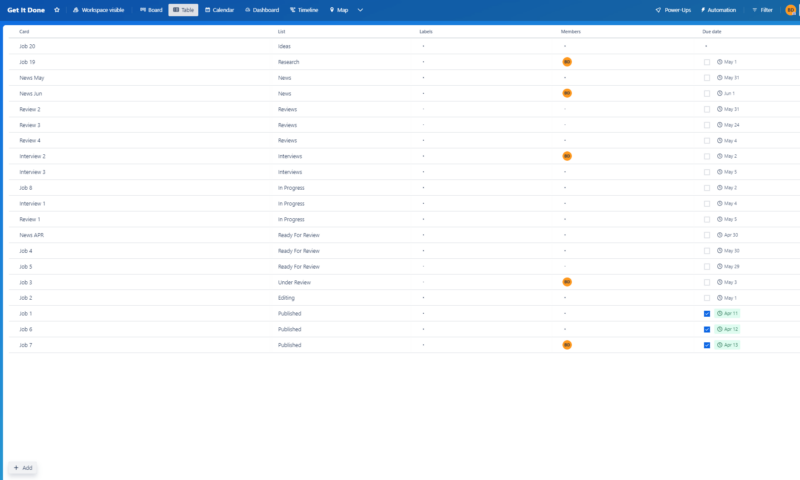
Trello’s table view is underwhelming when compared to the kanban.
Trello has more native task management tools, including a calendar, a table view and a dashboard, but you need to pay for them. Jira has no native tools beyond the board and timeline. You can expand your views through integrations, but for those who need to get up and running quickly, this may be a hassle you’d rather avoid.
Jira does have more tools for complex projects. It includes a space for issue and bug tracking, sprints and a road map to help visualize long-term goals.
Pricing
Expensive isn’t a word we would use to describe either platform, especially Trello. Granted, Trello is a little cheaper, with its Standard plan costing as little as $5 per user per month on annual billing, but Jira isn’t too far from that.
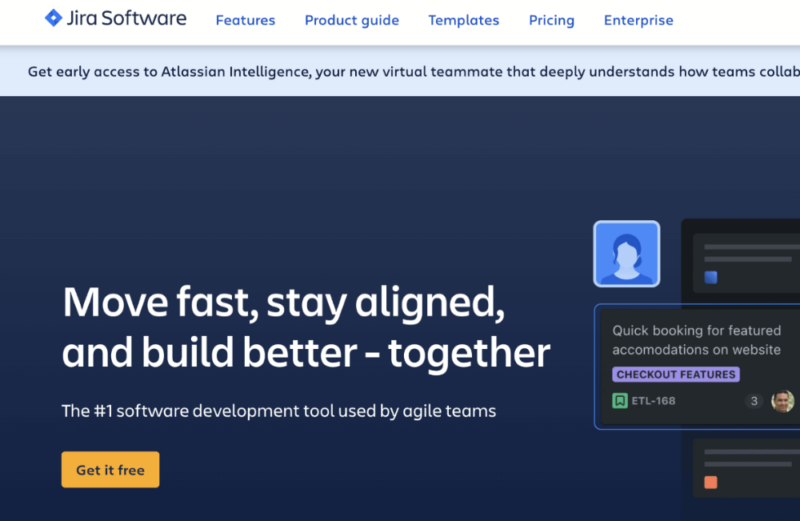
You can trial Jira’s Premium tier features for seven days before committing.
The main difference is the simplicity of the pricing. Whereas Trello goes for a standard pricing structure, Jira offers a fixed price with a fixed user limit.
For example, you’ll pay $850 per year for up to 10 users. That figure won’t change if you have fewer than 10 users, meaning it will be expensive for small and micro teams. You can learn more about Trello’s plans in our Trello pricing guide and Jira’s plans in our Jira pricing guide.
Terminology
Jira comes packed with plenty of terminology that software development teams will be accustomed to using. Epics, sprints, backlogs and the like are all ready for you to set up and work with. You can customize Trello, but it takes time, and if you want a quick start to your Agile project management, Jira is the better option.

